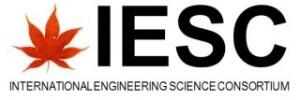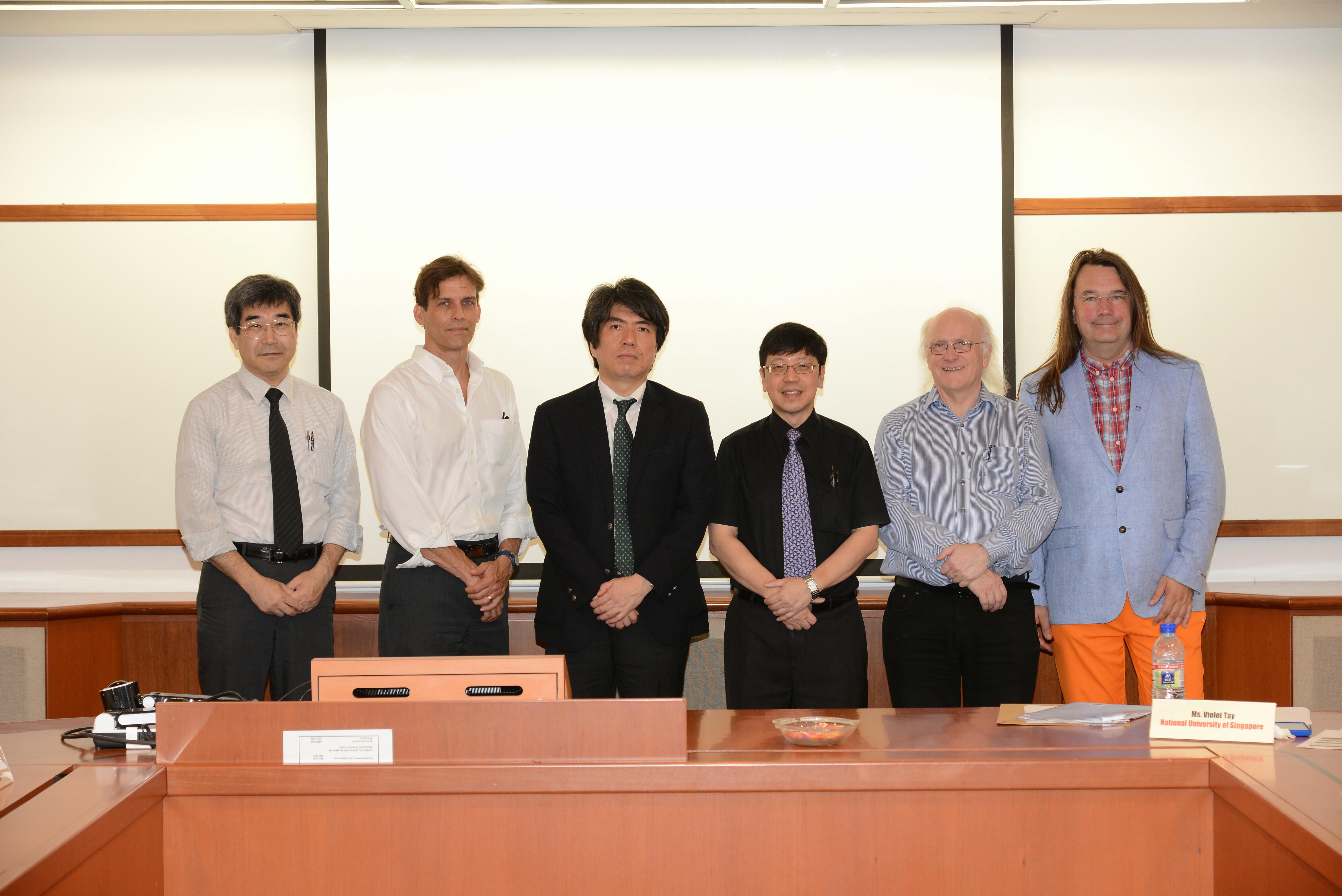Minutes of Second International Engineering Science Consortium Meeting Agenda
Date: 20th May 2015 09:00 - 12:30 hours Venue:National University of Singapore, Faculty of Engineering ECE Conference Room (EA-05-39) 9 Engineering Drive 1, #06-10, Singapore 117575
Chairperson:
| Prof. Genta Kawahara | Dean, Graduate School of Engineering Science Osaka University, Japan |
|---|
Attendees:
| Prof. Masao Tanaka | Professor, Graduate School of Engineering Science Osaka University, Japan |
|---|---|
| Prof. Leif Kari | Dean, School of Engineering Sciences Royal Institute of Technology (KTH), Sweden |
| Prof. Mark Kortschot | Chair, Division of Engineering Science Faculty of Applied Science & Engineering, University of Toronto Canada |
| Prof. Nick Tyler | Department of Civil & Environmental Engineering, University of College London, London (on behalf of Professor Anthony Finkelstein, Dean of Engineering Sciences) |
| Prof. Chien Ming Wang | Director, Engineering Science Programme National University of Singapore, Singapore |
| Assoc. Prof. Anjam Khursheed | Deputy Director, Engineering Science Programme National University of Singapore, Singapore |
Absent with apologies:
| Prof. David Attwood | Chair, Applied Science and Technology Graduate Group College of Engineering, University of California, Berkeley, USA |
|---|
Agenda Items
- Nomination of next consortium secretariat
- Nomination of next chairperson for IESC and terms of appointment
- New members for IESC
- Review of student exchange and Intnership
- Joint educational programmers between partner institutions
- International Engineering Science Certificate
- IESC website
- Research collaboration
- Next IESC meeting and symposium
- Any other business
The meeting was call to order by Prof. Kawahara with the welcoming of Prof. Nick Tyler to the meeting. Prof. Nick Tyler gave a brief background of University of College London. He explained UCL now has a Faculty of Engineering Science consisting of 10 departments and within each department it has faculty members with diverse expertise. For example in Civil Engineering, one can find also find Biologists, Microbiologists, Philosophers, etc. together with Civil Engineers. The curriculum of UCL is structured around multi-disciplinary and problem based learning.
1.Nomination of next Consortium Secretariat
Consortium Secretariat is responsible for co-ordinating meetings, archiving records and maintenance of IESC website since 2013. The meeting concurred that Osaka University continues to host the consortium secretariat for a further 2 years until the next IESC meeting in 2017. The Engineering Science leaders agreed to review the consortium secretariat every two years.
2.Nomination of next Chairperson for IESC and terms of appointment
The IESC Chairperson provides a visible leader to the consortium so that official meetings or documents that need the IESC endorsement may be handled readily. Prof. Kawahara was the Chair of the first meeting but the Consortium has yet to elect a Chairperson. In the meeting, the engineering science leaders elected Prof. Kawahara to be the IESC Chairperson for two years until the next IESC meeting in 2017. The meeting also decides that the Chairperson will be on a 2 year appointment for each term, and the Chairperson can hold the position for a maximum of two terms. Prof. Kawahara kindly accepted the appointment of the Chairperson for the IESC Consortium for two years until 2017.
3.New members for IESC
Prof. Kawahara explained that the current 5 partner institutions are located in 3 continents, namely Asia (NUS and Osaka Univ), North America (UOT and UCB) and Europe (KTH). With KTH being the only member in the Europe continent, Prof. Kawahara extended his invitation to Prof. Tyler for UCL to join the consortium. Prof. Tyler agreed to discuss further with his Dean of Faculty of Engineering Science. He requested an electronic copy of the MOU of the consortium.
With the possible joining of UCL, the consortium members are still located too far from one another. This poses financial and logistical difficulties for partner institutions to send large numbers of faculty members and/or students to attend events orgainsed by partner universities e.g. attending the International Symposium on Engineering Science. It is proposed to increase at least 1 or 2 more institution partners within the same continent in order to enhance the consortium and also activate regional interactions among the partner institutions within the same continent. The meeting decides that for a start, members could consider contacting the following universities to interest them about the consortium,
- Cornell University (Prof. Mark Kortschot to make contact) - University of Hong Kong (Prof. Wang and Prof. Kawahara to make contact) - ETH, Zurich (Prof. Leif Kari to make contact)
4.Review of Student Exchange Internship
Prof. Wang suggested that each institution could consider speaking to their International Offices to check if there is an existing MOU between institutions e.g. KTH has an existing University-wide MOU signed with NUS. Members could then propose negotiating a few of these positions solely for engineering science students of the consortium institutions.
5.Joint educational programmes between partner institutions
Various ideas were explored in the meeting. A few feasible ideas include Summer Programmes or Short Courses, e.g. 2 week programmes which will be almost equivalent to 39 hours of contact hours. Students could possible spend 2 weeks in one university and next 2 weeks in another university within the same continent. The Summer Programmes/Short Courses may be allowed to be mapped back into their courses of home programme. Each university will explore what possible courses are suitable. Topics should be general e.g. Finite Element Method and Human Factor Engineering, something which students could map into their engineering science curriculum.
It is suggested that it may be a good idea to plan the programmes/courses in July. Perhaps, such a programme can be organized to coincide with the symposium so that staff/students can attend the before or after the symposium.
6.International Engineering Science Certificate
The engineering science leaders agreed on the design of the International Engineering Science Programme certificate (see below).
 International Engineering Science Programme Certificate
awarded to
Name of Student
Home Institution
International Engineering Science Programme Certificate
awarded to
Name of Student
Home Institution
The certificate will be greatly appreciated by students who attended the various programmes that were organized by IESC members.
7.IESC Website http://www.engineering-science.org
Prof. Kawahara presented the IESC website to the members. Several comments were raised and adopted e.g. - Website to be named as "International Engineering Science Programmes" - allow a page each with short description of institutions followed by their websites; - in the Home Page, to include the institution name against each programme e.g. Graduate School of Engineering Science must be followed by Osaka University;
A/Prof Khursheed suggested using the website as a Notice Board. Members/Researchers could use it to publish/solicit news and information e.g. Opening for PhD scholarships, Research or Funding opportunities, etc.
Prof. Kawahara requested the information of the Student Workshop and Student Competition that were running concurrently with the meeting to be sent to him for posting on the website. He also asked members to revert to him for further comments on the website or information they wish to post on the website.
8.Research Collaboration
Prof. Kawahara explained that the website could be used as a platform for members to report on research findings or share information or calls of research collaborations. Interested researchers could also post their CVs or research interest so the others could search and engage each other for potential collaborations. Secretariat could send template for members to fill up should they be interested to post their credentials on the website. Prof Wang commented that contact details e.g. email address should be included so that contacts can be readily established.
9.Next IESC Meeting and Symposium
The next IESC meeting is agreed to be held in Sweden on 20-21 June 2017 (Wed-Thur). Note that 23rd June 2017 is a mid-Summer holiday in Sweden. Prof Kari informed that it is a great time to visit Sweden the mid-summer holiday is the most important event in Sweden.
Prof. Wang will supply Prof. Kari all the materials that were used in 2015 symposium e.g. proceedings, student workshops & activities, etc. which should be useful in the organization of the second symposium of IESC.
10. Any other Business
On the format of the symposium, Prof. Mark commented that the range of knowledge across Engineering Science is very broad and the technical papers presented in the symposium in any one area can pose a challenge for many to understand The meeting agreed for the next symposium to remind speakers to pitch the level at the senior standard of the Undergraduate level e.g. Year 4. It should focus on topics that summarize the latest review/progress over the last decade and to present it in layman's language for easy understanding. Primarily for students who are not in that area of research.
Recorded by: Ms. Violet Tay, Manager of NUS-ESP
Vetted by: IESC Engineering Science Leaders


